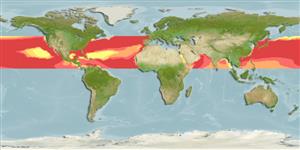分類 / Names
共通名の | 類義語 | Catalog of Fishes(部類, 種) | ITIS | CoL | WoRMS | Cloffa
>
Scombriformes (Mackerels) >
Tetragonuridae (Squaretails)
Etymology: Tetragonurus: Greek, tetra = four + Greek, gonia = angle + Greek, oura = tail (Ref. 45335).
More on author: Lowe.
Environment: milieu / climate zone / depth range / distribution range
生態学
海; 海洋回遊性 (Ref. 51243); 深さの範囲 0 - 800 m (Ref. 10823), usually 0 - 91 m (Ref. 7251). Subtropical; 47°N - 8°N
Atlantic, Indian and Pacific: in tropical and subtropical waters. Western Atlantic: Nova Scotia in Canada to Panama (Ref. 7251).
サイズ / 重さ / 年齢
Maturity: Lm ? range ? - ? cm
Max length : 50.0 cm TL オス/雌雄の選別がない; (Ref. 4415)
簡単な記述
検索表 | 形態学 | 形態計測学
背面の脊椎 (合計) : 14 - 17; 背鰭 (合計) : 10 - 13; 肛門の骨: 1; 臀鰭: 9 - 12; 脊つい: 44 - 51. Light brown to nearly black in color.
Oceanic, mostly in the upper 91 m but adults probably deeper (Ref. 7251). Occasionally strays close to shore (Ref. 7251). Young commonly inquiline in pelagic tunicates, especially Salpa and Pyrosoma (Ref. 11149). Feeds on soft-bodied medusae, ctenophores and especially salps; will also take plankton (Ref. 11149). The flesh may be poisonous (Ref. 27121).
Life cycle and mating behavior
成熟 | 繁殖 | 放精 | 卵 | 生産力 | 幼生
Haedrich, R.L., 1986. Tetragonuridae. p. 851. In M.M. Smith and P.C. Heemstra (eds.) Smiths' sea fishes. Springer-Verlag, Berlin. (Ref. 4415)
IUCNのレッドリストの状況は (Ref. 130435: Version 2024-1)
人間に対する脅威
Poisonous to eat (Ref. 27121)
Human uses
水産業: 興味がない
用具
特記事項
XMLをダウンロードして下さい
インターネットの情報源
Estimates based on models
Preferred temperature (Ref.
123201): 13.9 - 28.5, mean 24.8 °C (based on 1976 cells).
Phylogenetic diversity index (Ref.
82804): PD
50 = 0.7500 [Uniqueness, from 0.5 = low to 2.0 = high].
Bayesian length-weight: a=0.00389 (0.00180 - 0.00842), b=3.12 (2.94 - 3.30), in cm total length, based on all LWR estimates for this body shape (Ref.
93245).
栄養段階 (Ref.
69278): 3.6 ±0.37 se; based on food items.
回復力 (Ref.
120179): 低い, 4.5年~14年の倍増期間の最小個体群 (Preliminary K or Fecundity.).
Fishing Vulnerability (Ref.
59153): Moderate vulnerability (40 of 100).
